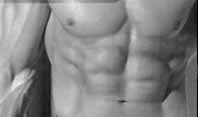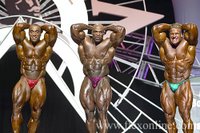 Introduction
Introduction Training of the abdominal muscles has recently been the subject of more misinformation and mythology than any other part of the human anatomy. Gizmos and gadgets abound that are alleged to give you those coveted "six pack" abs. But here's how you can rationally train your abs to their absolute maximum limits of development using everyday gym equipment.
What Builds Abdominal Muscles
There is nothing unique about abdominal muscle as far as their training and response to training is concerned. The principles that apply to biceps and triceps apply equally to abs. So the three critical elements of your ab workouts are: high intensity of muscular overload progressive intensity from workout to workout proper spacing of workouts to avoid overtraining or undertraining
Most people do sit-ups or crunches as an ab exercise. While these are basically good exercises that can satisfy point 1, above, how many people use them in a way that satisfies point 2?
Muscles will only develop in response to overload that is above normal. So if you do 20 crunches every day for a year, why would your ab muscles develop beyond that capacity? They won't. To force new development you need to increase the intensity. You could add a few crunches every day but that really just increases duration, there is a better way to get fast results.
Why TV Abdominal Machines Are a Joke

You've seen all those exercise gadgets on late night TV - lightweight gizmos that make it easier for you to rock back and forth on the ground while doing a crunch. Have you noticed that none of them allow you to add serious weight to increase intensity? Some have rubber bands or similar devices to add a bit of overload but it's a trivial amount.
I have seen people who have progressed to the point of doing crunches with 200 pounds! That's the kind of power and level of development your abs are capable of. Really! So fiddling around cheap equipment or those belts that "stimulate" your ab muscles using the minuscule power of two flashlight batteries is beyond laughable. Let's see two flashlight batteries generate the power to lift a man's torso and 300 pounds 20 times in one minute.
The Best Ab Exercises
I have tested common abdominal exercises and ranked them by their ability to deliver high intensity muscular overload. We tested ab machines, vertical leg raises, Roman chairs and others.
The winners were:
Weighted crunches
Weighted incline sit-ups
Weight sit-ups
The best way to do weighted crunches is to lie on the floor with your head close to the low pulley weight stack. Using the rope handle attachment, grasp the ends and pull the cable until it is tight and your hands are resting at the side of your head near your ears. Now contract your ab muscles in a crunch that lifts your shoulders off the floor and draws the weight stack up an inch or two. Chose a weight that is so heavy you can only to 8 to 12 reps.
If you don't have access to a low pulley, there is a good alternative. You can use the high pulley that is normally used for lat pulldowns. Kneel on the floor or sit in the seat directly under the rope handles that you attach to the high pulley. Lock your legs under the hold down. Pull the handles into position next to your ears then contract your ab muscles into a crunch that raises the weight stack an inch or two. Chose a weight that is so heavy you can only to 8 to 12 reps.
As a further alternative you can lie on the floor and do a sit up or crunch while holding a barbell plate against your chest. The limitation of this exercise it that, as you progress in strength it will not be possible to hold enough plates on your chest safely. But that's a good problem to have.
On each successive workout, shoot for a 5-15% increase in the weight you use. If you can't get a 5% increase it's time to add more days off between your workouts.
Conclusion
The Best Ab Exercises
I have tested common abdominal exercises and ranked them by their ability to deliver high intensity muscular overload. We tested ab machines, vertical leg raises, Roman chairs and others.
The winners were:
Weighted crunches
Weighted incline sit-ups
Weight sit-ups
The best way to do weighted crunches is to lie on the floor with your head close to the low pulley weight stack. Using the rope handle attachment, grasp the ends and pull the cable until it is tight and your hands are resting at the side of your head near your ears. Now contract your ab muscles in a crunch that lifts your shoulders off the floor and draws the weight stack up an inch or two. Chose a weight that is so heavy you can only to 8 to 12 reps.
If you don't have access to a low pulley, there is a good alternative. You can use the high pulley that is normally used for lat pulldowns. Kneel on the floor or sit in the seat directly under the rope handles that you attach to the high pulley. Lock your legs under the hold down. Pull the handles into position next to your ears then contract your ab muscles into a crunch that raises the weight stack an inch or two. Chose a weight that is so heavy you can only to 8 to 12 reps.
As a further alternative you can lie on the floor and do a sit up or crunch while holding a barbell plate against your chest. The limitation of this exercise it that, as you progress in strength it will not be possible to hold enough plates on your chest safely. But that's a good problem to have.
On each successive workout, shoot for a 5-15% increase in the weight you use. If you can't get a 5% increase it's time to add more days off between your workouts.
Conclusion

There is no mystery to developing your abdominal muscles to the limits of their genetic potential. And you certainly don't need quirky gadgets. High intensity exercises that can be progressed from workout to workout will have you sporting that six pack.




